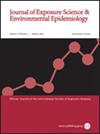北卡罗莱纳队列中社区绿化与出生结果之间的关系。
IF 4.7
3区 医学
Q2 ENVIRONMENTAL SCIENCES
Journal of Exposure Science and Environmental Epidemiology
Pub Date : 2025-05-21
DOI:10.1038/s41370-025-00780-4
引用次数: 0
摘要
背景:较高水平的社区绿化与改善的出生结果有关。然而,许多研究使用的指标依赖于植被密度,无法区分绿化类型或空间背景,这可能导致潜在效益的变化。目的:我们研究了不同空间背景(即基于欧几里得距离和网络距离的缓冲区,以及代表整体、街道和道路附近绿化的繁忙道路)下,低出生体重(TLBW)和早产(PTB)与不同类型的社区绿化(即树木覆盖、草本覆盖和总体绿化)之间的关系。方法:使用2003年至2015年北卡罗来纳州出生登记数据创建单胎活产队列,并与EnviroAtlas中的绿化指标相关联。使用Logistic回归模型估计绿化指标与TLBW之间关联的OR (95%CI)。结果:我们观察到社区绿化的多种测量与TLBW和PTB之间存在适度的关联。我们的大多数结果表明,随着社区绿化水平的提高,不良分娩结局的几率降低,但一些关联显示不良分娩结局的几率增加。总体绿化总量与TLBW的相关性最强(0.967[0.939,0.996]),与PTB的相关性最强(0.985[0.971,0.999])。我们还发现非西班牙裔黑人母亲中绿道密度增加与TLBW之间存在意想不到的关联(1.181[1.049,1.326])。相反,我们观察到非西班牙裔白人母亲患PTB的几率与绿道密度增加相关(0.926[0.871,0.983])。影响声明:我们研究了不良出生结果与不同类型的社区绿化之间的关系,一般发现随着社区绿化水平的增加,不良出生结果的几率降低,基于欧几里得距离的总绿化与低出生体重的几率降低之间的联系最强。然而,我们也在非西班牙裔黑人母亲中观察到意想不到的与绿道密度增加和足月低出生体重增加的关联。这些结果强调了考虑绿色空间可能或不可能使某些社区受益的方式的重要性,并将在指导未来增加生态价值或恢复邻里绿色空间的努力中发挥重要作用。本文章由计算机程序翻译,如有差异,请以英文原文为准。

Associations between neighborhood greenery and birth outcomes in a North Carolina cohort
Higher levels of neighborhood greenery have been associated with improved birth outcomes. However, many studies use metrics relying on vegetation density and are not able to distinguish types of greenery or spatial context, which may result in variation in potential benefits. We examined relationships between term low birth weight (TLBW) and preterm birth (PTB), and different types of neighborhood greenery (i.e., tree cover, herbaceous cover, and aggregate greenery) within various spatial contexts (i.e., Euclidean distance and network distance-based buffers, and busy roadways to represent overall, street, and near-road greenery). North Carolina birth registry data from 2003 to 2015 were used to create a singleton live birth cohort and linked to greenery metrics from EnviroAtlas. Logistic regression models were used to estimate OR (95%CI) for associations between greenery metrics and TLBW (<2500 g) or PTB (<37 weeks gestational age) adjusting for potential confounders. Analyses were stratified by race/ethnicity, as many studies report potential differences in proximity to greenery across these groups. We observed modest associations between multiple measures of neighborhood greenery and TLBW and PTB. Most of our results indicated a decreased odds of adverse birth outcomes with increasing levels of neighborhood greenery, but some associations showed increased odds of adverse birth outcomes. We observed the strongest associations between overall aggregate greenery with TLBW (0.967 [0.939, 0.996]) and near-road tree cover with PTB (0.985 [0.971, 0.999]). We also observed unexpected associations between increased greenway density and TLBW among non-Hispanic Black mothers (1.181 [1.049, 1.326]). In contrast, we observed a decreased odds of PTB associated with increased greenway density for non-Hispanic white mothers (0.926 [0.871, 0.983]). We examined relationships between adverse birth outcomes and different types of neighborhood greenery, generally finding decreased odds of adverse birth outcomes with increasing levels of neighborhood greenery, with the strongest associations between aggregate greenery based on the Euclidean distance and decreased odds of term low birth weight. However, we also observed unexpected associations with increased greenway density and increased term low birth weight among non-Hispanic Black mothers. These results highlight the importance of considering the ways greenspace may or may not benefit some communities and will be important in guiding future efforts to increase instorative value or restore neighborhood greenspaces.
求助全文
通过发布文献求助,成功后即可免费获取论文全文。
去求助
来源期刊
CiteScore
8.90
自引率
6.70%
发文量
93
审稿时长
3 months
期刊介绍:
Journal of Exposure Science and Environmental Epidemiology (JESEE) aims to be the premier and authoritative source of information on advances in exposure science for professionals in a wide range of environmental and public health disciplines.
JESEE publishes original peer-reviewed research presenting significant advances in exposure science and exposure analysis, including development and application of the latest technologies for measuring exposures, and innovative computational approaches for translating novel data streams to characterize and predict exposures. The types of papers published in the research section of JESEE are original research articles, translation studies, and correspondence. Reported results should further understanding of the relationship between environmental exposure and human health, describe evaluated novel exposure science tools, or demonstrate potential of exposure science to enable decisions and actions that promote and protect human health.

 求助内容:
求助内容: 应助结果提醒方式:
应助结果提醒方式:


